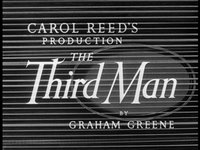The Third Man (1949)
Published Friday, May 12, 2006 by modium. The Third Man (1949)
The Third Man (1949)The Third Man is a wonderful film. A wonderful fucking film. It's one of those 'magic of cinema' films that reminds you of how great a movie can be when everything comes together. And come together, it does. There's nary a weak link in the Third Man; great script, excellent pacing, fine direction, wonderfully skewed photography, blazing performances, and one of the best and most memorable scores ever laid down.
Even though I'd seen it before, I was almost instantly absorbed into the film. In the great noir tradition, Joseph Cotton plays Holly Martins with a certain smugness and curiosity that makes him a great protagonist. As we slowly descend into the underworld along with Holly, we begin to learn about him by the way he reacts to all of it; his moral compass is unraveled before us with every step.
I know that the Hollywood tradition is to find an exotic locale, photograph it beautifully, and toss in some plot to tie it all together. But, Vienna stands out as the perfect locale for Carol Reed's masterwork. The cobblestone streets, the various dilapidated buildings, the different parts of the city, which, eventually, trap the characters where they are, and, of course, the sewers!
If Vienna stands out as an obvious choice for a city in which to set a film noir, then the zither stands on the opposite end of the spectrum; an idea that's so hilariously wrong for the story at first glance, but, the more you think it, does fit the finished film like a glove. First off; it's catchy. Every time I see the Third Man, I always have the Harry Lime theme running through my head for a week afterwards. But, it functions like the cinematography, as something that calls attention to itself because it seems so out of place, which puts the viewer slightly off-kilter, ready for anything and everything to pop out of the fog.
The cinematography should be touched upon, too, since it's one of the best-looking films to come out of the 50's or any other time period. Sometimes, when shooting a film, the camera is placed at a skewed angle to throw the viewer's eye (and psyche) slightly off balance. But, Robert Krasker places the camera at a strange angle for nearly every shot in the film, so much that when cutting to a 'normal' angle, the entire film seems to be slightly off balance. Of course, Vienna's slick cobblestone streets and deep, foggy nights don't hurt either.
Even when you know it's coming, Harry Lime's appearance is almost always a surprise. You can see it coming a mile away; you know Welles is in the film, every other sentence spoken in it contains Harry's name, and then there's the business with the cat curling at his feet. Yet, Reed uses this anticipation to his advantage by holding Harry's reveal in suspense for a few extra moments. Finally, the old woman turns on her light and in a flash, Orson Welles is revealed. Prefiguring his mischievous turn as performer in his own F for Fake, he grins like an overgrown cherub, elated with all the fuss he's caused so far.
Even after that, the story doesn't let up until the end, as Holly and Harry are engaged in a kind of an epic struggle of, essentially, Good Vs. Evil. It's enough to remind you of why we watch movies in the first place.
modium
- Rhode Island, United States
- My profile
Links
Other Nerds
Last posts
- crisp filmy - 3 weeks of Metal Gear!
- crisp filmy - Week of 5/26/08
- crisp filmy - Weeks of 5/12/08 & 5/19/08
- crisp filmy - Week of 5/5/08
- Favorite Films - New and Revised!
- Gates of Heaven (1978)
- Merry Christmas to Luke - 2001: A Space Odyssey (1...
- Sven Nykvist Memorial - Part 4: The Virgin Spring
- Modium goes region free!
- Sven Nykvist Memorial - Part 3: Crimes and Misdeme...
Archives
- 2005-06-26
- 2005-07-03
- 2005-07-10
- 2005-07-17
- 2005-07-24
- 2005-07-31
- 2005-08-07
- 2005-08-14
- 2005-08-21
- 2005-08-28
- 2005-09-04
- 2005-09-11
- 2005-09-18
- 2005-09-25
- 2005-10-02
- 2005-10-09
- 2005-10-16
- 2005-10-23
- 2005-11-06
- 2005-11-27
- 2006-01-29
- 2006-03-26
- 2006-04-02
- 2006-04-09
- 2006-04-30
- 2006-05-07
- 2006-05-28
- 2006-06-25
- 2006-07-09
- 2006-07-23
- 2006-08-06
- 2006-08-27
- 2006-09-03
- 2006-09-10
- 2006-09-17
- 2006-10-08
- 2006-11-19
- 2006-11-26
- 2006-12-03
- 2007-02-25
- 2007-06-17
- 2008-05-11
- 2008-05-25
- 2008-06-01
- 2008-06-22

